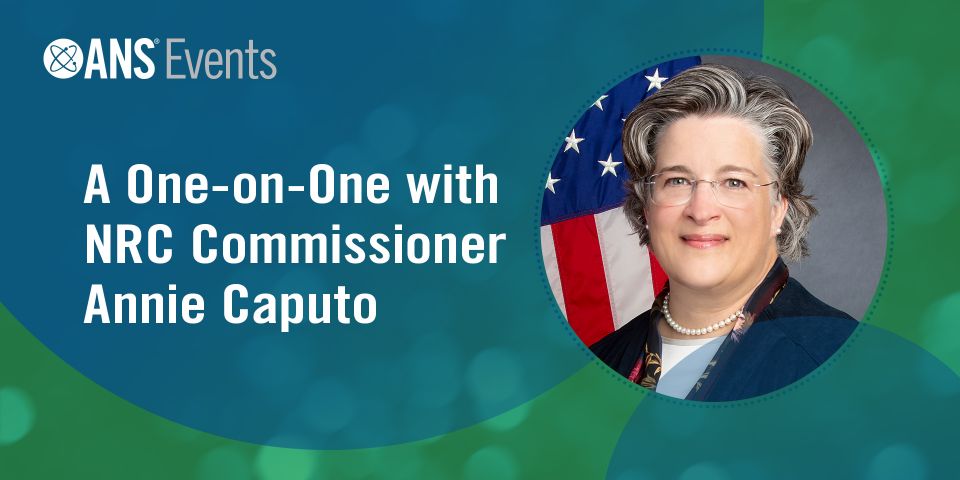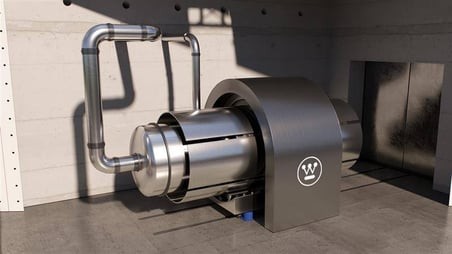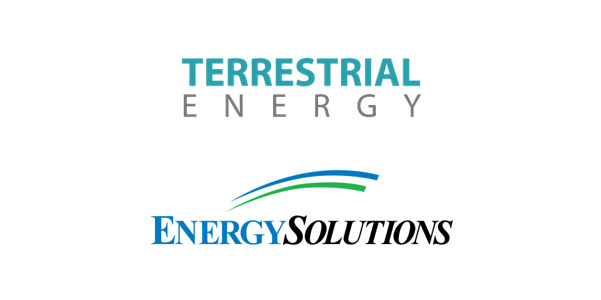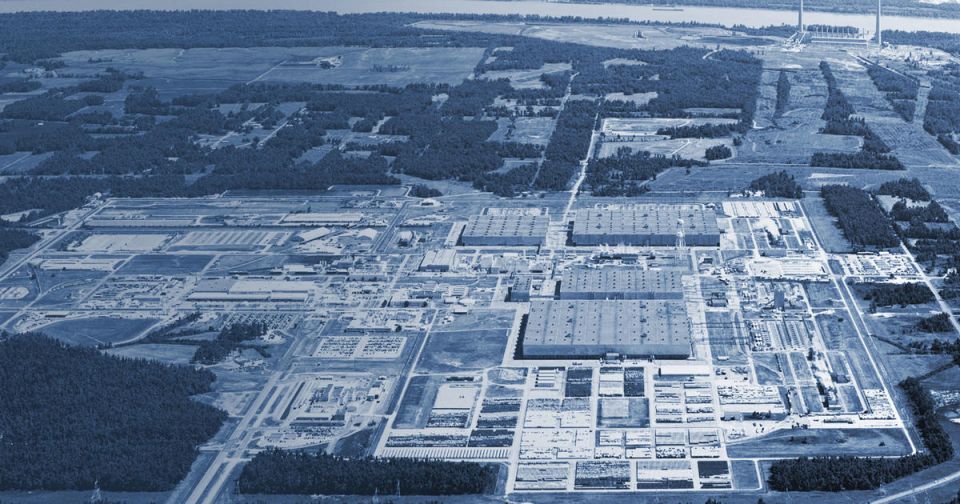Developing a new regulatory framework for advanced reactors: Update on Part 53

White
The American Nuclear Society’s Risk-informed, Performance-based Principles and Policy Committee (RP3C) on March 29 held another presentation in its monthly Community of Practice (CoP) series. The presenter, Patrick White with the Nuclear Innovation Alliance (NIA), talked about the current status of efforts to develop a new regulatory framework for advanced reactors—known as 10 CFR Part 53 or simply Part 53. White serves as the research director of the NIA, where he leads their research as well as analysis-based stakeholder and policymaker engagement and education. White’s March 29 presentation is publicly available on YouTube and at ANS’s publication platform Nuclear Science and Technology Open Research (NSTOR).
RP3C chair N. Prasad Kadambi opened the CoP with brief introductory remarks about the RP3C before he welcomed White as the session’s presenter.
White covered three main topics: the history of the existing regulatory frameworks for new reactors, progress to date on the development of the Part 53 rule for advanced reactors, and the current status and next steps for the Part 53 rulemaking process.
Existing regulatory framework for new reactors
The earliest nuclear regulations in the U.S. enabled the construction and operation of a wide variety of different reactor technologies. During the early days of nuclear regulation, the Atomic Energy Commission—the predecessor of the current U.S. Nuclear Regulatory Commission—was able to efficiently review and approve a variety of different nuclear technologies. These included the Pathfinder Nuclear Generation Station (1966), a superheated boiling water reactor; Hallam Nuclear Generating Station (1963), a liquid sodium–cooled and graphite-moderated reactor; and the Piqua Nuclear Generating Station (1963), an organic-cooled and -moderated reactor. “It is really interesting to think how the regulatory framework that was initially used enabled these reactors,” White remarked, given how different these technologies are from the light water reactor technologies employed by the U.S. today.
As LWRs became the dominant commercial nuclear technology, nuclear regulations were slowly optimized to enable the more efficient regulation of LWRs. While the earliest reviews focused on expert review to support regulatory decisions—at a time when there wasn’t substantial operating or regulatory experience—later reviews relied more heavily on prescriptive and technology-specific requirements. Current reactor siting requirements, general design criteria for nuclear power plants, and standardized design-basis safety analyses are examples of more prescriptive requirements that developed over time. These regulatory requirements formed the licensing basis for the nuclear power plants operating today in the U.S. “When we take a look at what are essentially the bases of these regulations,” said White, “in my perspective, it comes down to the combination of design requirements, methodology requirements, and programmatical requirements.” Modern nuclear regulations in the U.S. rely on technology-specific, prescriptive, and deterministic requirements to ensure the safety of nuclear power plants.
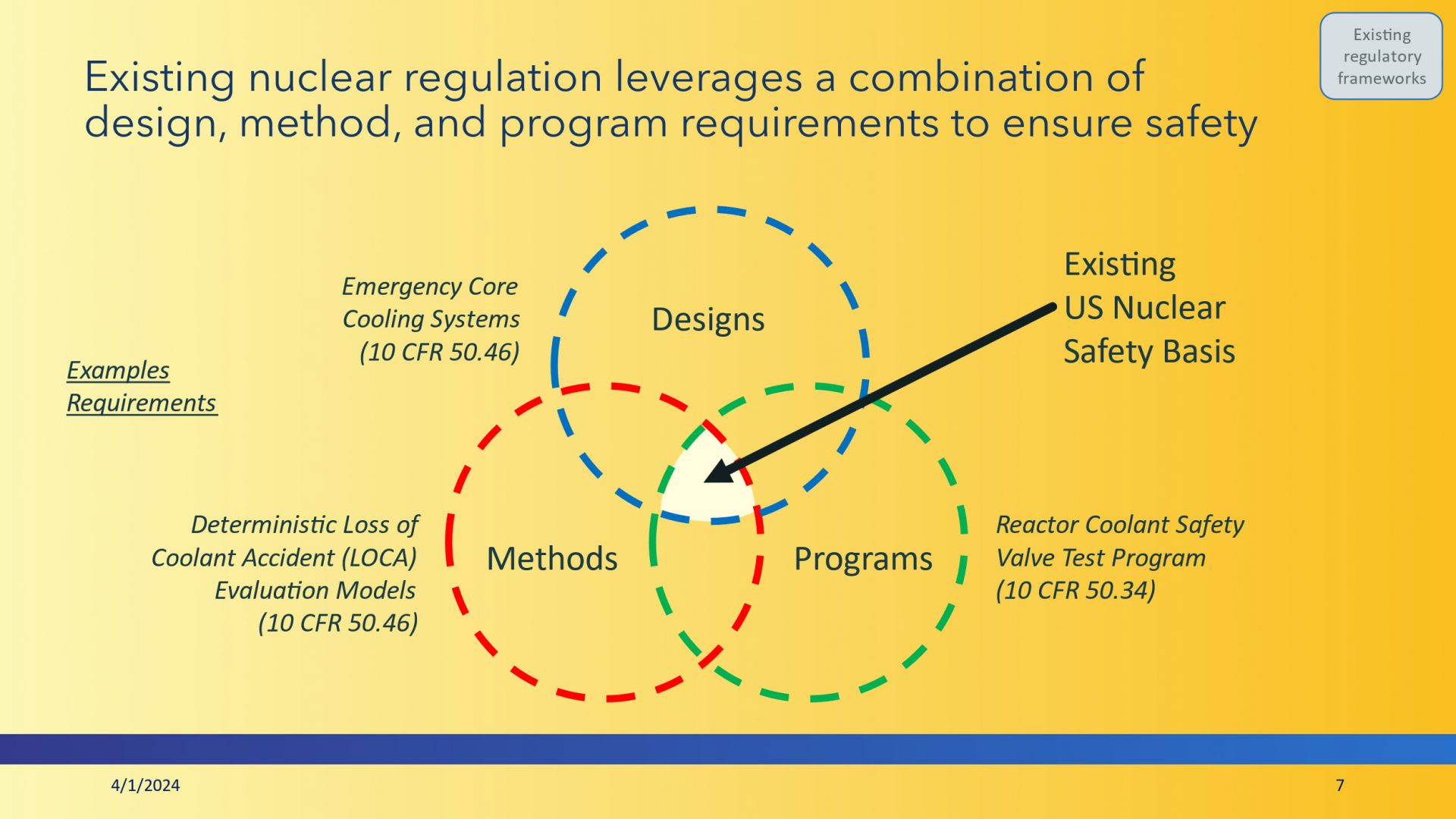
For example, if we examine regulatory requirements on new nuclear power plants today, such as for the reactor coolant system, we can see that the existing regulations in 10 CFR Part 50 have specific design requirements on emergency core coolant systems, specific methodological requirements on how you would evaluate the deterministic loss-of-coolant accident and evaluation models, and programmatic requirements on things like the reactor coolant safety valve test program. The combination of these design factors, methodological factors, and programmatic factors enables the safe operation of nuclear power plants today, but these have all been largely optimized for large LWRs. If we use these same regulations in the future for many advanced reactors, we will need to develop regulatory exceptions from many requirements.
White highlighted that the designs proposed for X-energy’s high-temperature gas-cooled reactor, NuScale Power’s small modular light water reactor, and Westinghouse’s eVinci heat pipe reactor all would likely have safety cases that differ significantly from those for existing large LWRs. Licensing these reactors using existing regulations would require use of regulatory exemptions and proposal of alternative requirements, potentially leading to a cumbersome and unpredictable licensing process.
Technology-specific, deterministic, and prescriptive regulatory requirements can ultimately impede the new licensing of advanced reactors by creating a more challenging process. While it is possible to license new reactors using the regulatory exception process, the first movers completing the regulatory process now are demonstrating that the process may not be efficient or predictable. Technology-specific requirements can impede the licensing of non-LWR technologies, required deterministic methods might limit the use of risk insights or applicability of risk insights in design and operation, and prescriptive requirements on design or programmatic operations could discourage technology innovation. A future regulatory framework should start to move toward being is more technology-inclusive, risk-informed, and performance-based with the goal of creating a framework that provides a more robust basis for nuclear regulation and enables a more effective licensing of advanced reactor technology.
The idea of creating a technology-inclusive, risk-informed, and performance-based process isn’t new and is already being applied to the existing regulatory framework. The best example is the Licensing Modernization Project (LMP), which was created as a methodology for licensing new advanced reactors using the existing regulatory requirements and exemptions. LMP developed a technology-inclusive, risk-informed, and performance-based methodology that could be used to inform the licensing basis and the content of applications for non-LWRs licensed using 10 CFR Part 50 or 10 CFR Part 52. LMP was led by Southern Company and partnered with the industry’s Advanced Reactor Regulatory Task Force to produce the industry guidance document NEI 18-04 (Rev. 1), Risk-Informed Performance-Based Technology Guidance for Non-Light Water Reactor Licensing Basis Development. NEI 18-04 outlines processes that include the selection and evaluation of licensing-basis events; the classification of structures, systems, and components; and the determination of defense-in-depth adequacy. The goal of LMP was to develop a technology-inclusive, risk-informed, and performance-based process and help different potential applicants identify how this process could be implemented under the existing regulatory framework.
The industry work on NEI 18-04 led to acceptance of the methodology by NRC staff in SECY-19-0117, Technology-Inclusive, Risk-Informed, and Performance-Based Methodology to Inform the Licensing Basis and Content of Applications for Licenses, Certifications, and Approvals for Non-Light-Water Reactors. The NRC endorsed usage of the LMP methodology in 2020 in Regulatory Guide (RG) 1.233, Guidance for a Technology-Inclusive, Risk-Informed, and Performance-Based Methodology to Inform the Licensing Basis and Content of Applications for Licenses, Certifications, and Approvals for Non-Light-Water Reactors. The endorsement of LMP provides an established methodology that advanced reactor developers can use to license non-LWRs or advanced reactors under the existing regulatory framework in a way that is technology-inclusive, risk-informed, and performance-based. The challenge, however, is that these processes all try to integrate advanced reactor licensing into a regulatory framework that has been largely optimized for large LWRs. As we develop the regulatory systems of the future, there is a need to develop a new regulatory framework that more easily and natively integrates technology-inclusive, risk-informed, and performance-based regulation.
A brief history of Part 53 rulemaking for advanced reactors
The NRC’s work on Part 53 and other advanced reactor rulemaking activities builds on decades of the NRC and other stakeholders trying to develop more risk-informed, performance-based (RIPB) regulations. Probabilistic risk methods for nuclear applications were first developed in the late 1970s, but the NRC documents only began to formally accept and increase use of probabilistic risk assessments (PRAs) in nuclear regulatory activities in the 1990s. Throughout the 1990s, there was increased support from the Commission for implementation of RIPB regulation. In the 2000s, the NRC staff and the Commission worked to increase the use of RIPB regulations. In 2003, NRC staff developed regulatory guidance on performance-based regulation that could support implementation of a larger RIPB regulatory framework. In 2007, NRC staff published NUREG-1860, Feasibility Study for a Risk-Informed and Performance-Based Regulatory Structure for Future Plant Licensing, which documented a feasibility study for creating an RIPB regulatory structure for future plant licensing. The studies and reports in the 2000s demonstrated that the NRC was building experience in RIPB regulation and developing the theoretical and technical basis for a new regulatory framework.
In the 2010s, the NRC staff continued work on RIPB regulation, including NRC’s report NRC Vision and Strategy: Safely Achieving Effective and Efficient Non-Light Water Reactor Mission Readiness, which focused on the long-term need to create a new regulatory framework that is technology-neutral, risk-informed, and performance-based. The Commission and staff also developed additional white papers that outlined how the NRC could develop modern risk-informed regulation for advanced nuclear power plants. The development of RIPB methods cumulated in the NRC review of NEI 18-04 and its endorsement in RG 1.233. As the NRC began work on a new regulatory framework for advanced reactors in the 2020s, it was building on decades of work by the NRC staff and the larger safety analysis community to provide the theoretical, technical, and practical basis for new reactor regulation.
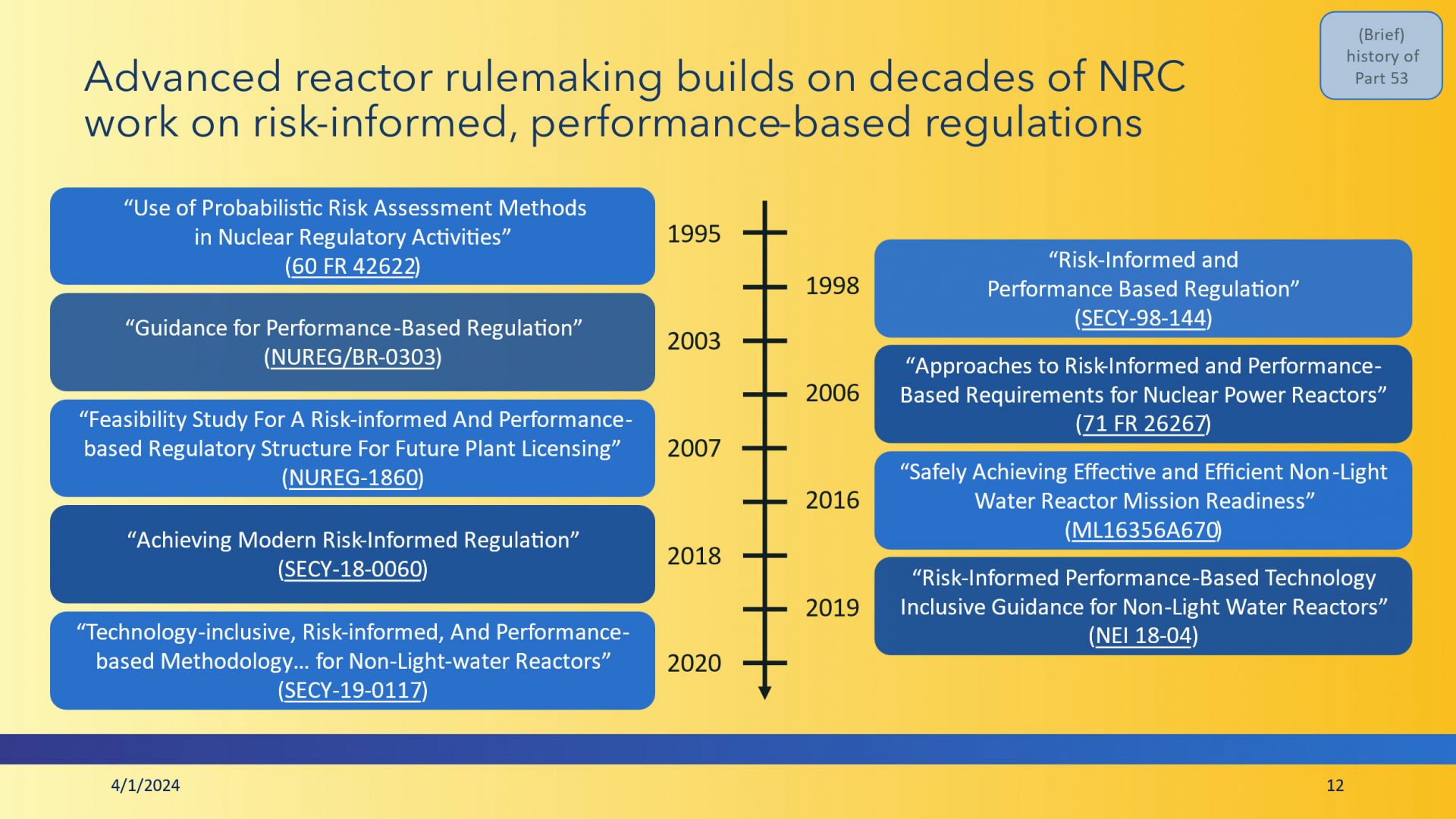
The Nuclear Energy Innovation and Modernization Act (NEIMA), signed into law in 2019, formally started the rulemaking directing the NRC to develop 10 CFR Part 53. NEIMA had bipartisan cosponsors on the Senate Environment and Public Works Committee. The act was passed with broad bipartisan support in both the House and the Senate. One of the provisions within NEIMA was a requirement for the NRC to complete a rulemaking to establish a technology-inclusive regulatory framework for optional use by commercial advanced nuclear reactor applicants for new reactor license applications no later than December 31, 2027. The act also talks about the need for the framework to be risk-informed and performance-based.
The NRC staff began the process of developing the plan for the new Part 53 rulemaking in 2019 based on the direction from NEIMA. The NRC’s initial rulemaking plan was outlined in SECY-20-0032, Rulemaking Plan on “Risk-Informed, Technology-Inclusive Regulatory Framework for Advanced Reactors”, and provided a plan for building on the LMP methodology and the work previously done by internal and external stakeholders as the technical basis for the new Part 53 regulatory framework. The NRC staff’s plan was to develop a new rule that had as few connections as possible to Part 50 and Part 52 and to provide significant public outreach activities throughout the development of Part 53.
The initial NRC staff schedule for completing the rulemaking by the end of 2027 was accelerated based on stakeholder and policymaker feedback. The NRC approved an accelerated schedule for completing Part 53 by reducing the amount of time that staff was allocated to develop the proposed rule. The accelerated schedule led, in part, to the development of the Part 53 proposed draft rule using an LMP-like framework. NRC staff issued a draft proposed rule outline in the summer of 2021. Similar to the LMP methodology, the NRC staff’s initial plan for the Part 53 regulatory framework included the use of PRA in a lead role—i.e., used to help define the licensing-basis events for an application. There would be additional licensing metrics based on insights from the PRA, and NRC staff stated that additional required plant operating programs that leveraged insights from PRA would give the operators more flexibility with their design and operations.
The NRC has had extensive public engagement with the external stakeholders on the proposed draft rule. The engagement process has resulted in much feedback—and conflicting feedback—from external stakeholders on multiple topics, including on the use of PRA. Specifically, external stakeholder feedback was not uniform that an LMP-like framework would be appropriate for all future applicants. There was interest in how to develop different application methodologies that would not rely as heavily on PRA either in a leading role or that may not rely on PRA at all. Based on this mixed stakeholder feedback, the NRC staff started the development of what was called “Part 5X Supplement,” or the “Technology-inclusive alternative requirements for commercial nuclear plants.” The NRC staff looked at how they could develop a new regulatory framework within the Part 53 rule that could leverage Part 50 requirements and align more with international requirements for nuclear reactor licensing, turning an eye toward long-term licensing harmonization. The idea of Part 5X was to create more options for the use of risk evaluations in new reactor licensing, including an enhanced PRA approach; a traditional PRA approach; and a new methodology called a technology-inclusive, risk-informed maximum accident approach. Development and formalization of Part 5X required additional NRC staff effort and time and led, in part, to a six-month extension to the schedule.
In 2022, the NRC incorporated the more deterministic framework in Part 5X into a second licensing pathway called Framework B. The second licensing pathway incorporated existing innovations that were already found in the work done by staff in Part 53 and more heavily leveraged Part 50 and Part 52 rule language. The Framework B pathway was considered more compatible with international standards and also included more unique innovative licensing approaches that enable use of traditional risk insights in both the licensing and operation of advanced reactors. Framework B also included a new methodology, “Alternative Evaluation for Risk Insights,” which facilitated a more deterministic assessment of risk and focused more on the development of principal design criteria for nuclear power plants, in contrast to what was done with the LMP methodology.
The development of Framework B resulted in a new multipart rule. Part A of the new rule would contain general provisions about the rule applicable to all frameworks. Framework A would contain a more traditional LMP-like methodology with PRA in a leading role. Framework B would contain the more traditional licensing process with deterministic methods or PRA in a confirmatory role. The NRC staff finalized the proposed draft rule and submitted the draft rule to the Commission in March 2023 for their review and approval. The proposed draft rule was submitted to the Commission in SECY-23-0021, Proposed Rule: Risk-Informed, Technology-Inclusive Regulatory Framework for Advanced Reactors.
Current status and next steps on Part 53 rulemaking process
During the Part 53 rulemaking process, external stakeholders expressed concern about the direction of the process. Many stakeholders stated in public meetings and in public comments that they believed that the Part 53 rulemaking was too complex, overly burdensome, and had limited benefits. Other stakeholders questioned the benefits of the LMP-like methodology in Part 53 beyond the existing regulatory framework and whether Part 53 would improve the licensing timelines for new advanced reactors. These questions and concerns expressed by stakeholders were considered by the Commission as they were working through the process to evaluate the staff’s proposed draft rule.
The Commission’s voting process on policy issues is a combination of public and confidential processes. The voting process typically starts with an NRC Staff Memorandum to the Commission (SECY), where the NRC staff outlines the request for a commission vote or decision on a specific topic. The SECY is publicly available, but the Commissioners then work privately to develop their individual votes. The Commissioners can vote to approve or disapprove the questions in the SECY in whole or in part, and they provide written comments and feedback to the staff for the record. The votes are developed privately by the individual Commissioners and are submitted to the Commission secretary for the record. The votes typically are held as confidential until all votes have been finalized, but Commissioners have the ability to release their votes on any SECY at any time as they see fit. The next step in the process is that the Commission, the Commission secretary, and the Commission staff work to develop a majority position that can represent a majority vote across the Commission on topics relative to the SECY. Development of both individual Commission votes and creation of a majority Commission position on a SECY can sometimes take weeks, months, or even years depending on the Commission prioritization of the rulemaking.
Ultimately, the Commission voting process is completed confidentially, but the Commission voting process results in two public documents. The first document is a majority Commission direction to the staff typically called a Staff Requirement Memorandum (SRM) that represents the Commission’s overall response to the SECY. The second document is the complete Commission Voting Record that provides the individual votes of the Commissioners and some insight into what led to the majority decision. These documents are critical in evaluating the current status and next steps on the Part 53 rulemaking process.
The Part 53 SECY was submitted to the Commission in March 2023 with the request that the Commission approve the proposed draft rule for release and formal public comment. The Commissioners began developing their votes on the SECY, and in August 2023, several Commissioners decided to publicly release their votes on the proposed draft rule. The first vote released publicly was from Commissioner Annie Caputo. Commissioner Caputo provided specific directions to the staff on how to reduce the complexity and scope of the proposed rule. Her markup on the rule included removing new regulatory requirements, removing new operational programs, simplifying regulatory requirements, and removing Framework B with the intent to have the insights included in future updates to Part 50 and Part 52. The second vote publicly released was from Commissioner David Wright. Commissioner Wright focused on providing direction to the staff to revise regulatory risk metrics, move many details of the rule into regulatory guidance, provide a simplified rule structure, and propose the use of applicant safety case. These two votes represented significant changes to the NRC staff’s proposed draft rule.
On March 4, 2024, the full Commission released their votes and the final SRM, Staff Requirements—SECY-23-0021—Proposed Rule: Risk-Informed, Technology-Inclusive Regulatory Framework for Advanced Reactors. The NRC Commission’s final vote provided substantial direction to the NRC staff to make significant modifications to the proposed draft rule. The SRM was a strong composite of Commissioners Caputo’s and Wright’s public votes along with direction from Commissioner Crowell’s and Chair Hanson’s votes. The Commission’s final vote included several major topics for staff consideration, including a revision of the rule’s regulatory metrics, clarification on the use of PRA and risk information, the removal of many of the new regulatory requirements and operational programs, editorial and terminology corrections along with a simplified rule structure, and greater emphasis on flexibility. The Commission also directed removing Framework B from Part 53 and instructed staff to provide a follow-up SECY with options on how the NRC staff could incorporate work on Framework B into existing rules or regulatory guides. The changes directed by the Commission addressed many external stakeholder concerns. The Commission’s vote gives the NRC staff six months to prepare a revised rule for public comment that would be submitted back to the Commission for review and approval by September 2024. Even with these directed changes and additional activities, the NRC is still on track to make the NEIMA deadline to complete rulemaking in 2027. A proposed draft rule for public comment is now expected in the spring of 2025.
About RP3C
The ANS Standards Board established RP3C to support knowledge sharing of the development and application of RIPB principles and practices within the nuclear industry. This CoP is considered part of the RIPB training activity under the RP3C. The CoP is typically held on the last Friday of the month at 3:00 p.m. eastern time. Membership in this CoP is open to all professionals interested in RIPB principles and practices. Links to over 40 CoP presentation recordings are available on the CoP’s webpage, and many of the presentations are available at NSTOR. Contact standards@ans.org to inquire about being a presenter and for any questions.



